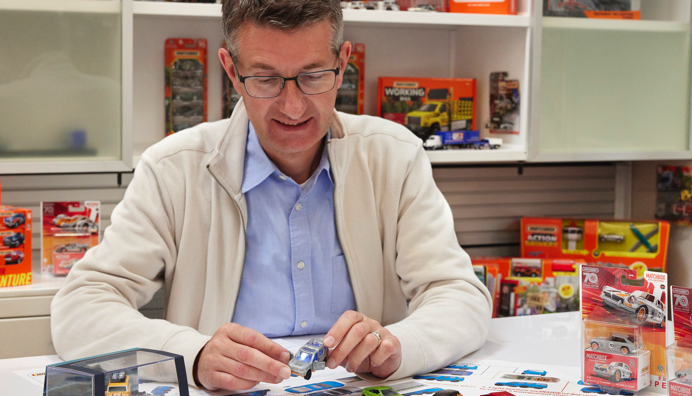Following the huge commercial success of the Barbie movie, Mattel is celebrating the 70th anniversary of Matchbox toys and cars. To honour this milestone, it recently unveiled a limited-edition line of die-cast vehicles, available for sale at Big W, which is aimed at loyal collectors. Here, Julian Payne – senior design manager for Matchbox – discusses what he has learned while working at Mattel for over 25 years. He shares how the brand’s products and the toy industry at-large has evolve
lved over the years, how Matchbox continues to appeal to audiences young and old, and what’s next for the iconic brand.
Inside Retail: How did you get started with Mattel and Matchbox, and what’s kept you in the role for 25 years?
Julian Payne: I got started in my career when I joined the Mattel vehicle design group, which was based in Leicester, England. However, it wasn’t until January 2000 when I relocated to the Matchbox office in New Jersey, US, that I started working on Matchbox. My motivation comes from creating fun and engaging toys for kids of all ages. Seeing them being bought in stores and becoming a positive part of people’s memories is very rewarding.
Over the past 25 years, I’ve witnessed significant advancements in technology, which have streamlined our design process and enabled us to create more intricate and realistic models. What has remained consistent is the dedication to capturing the essence of vehicles in miniature form, maintaining the connection between the real and the miniature. What’s motivated me in this role is the ability to tell stories through our models, to inspire young minds, and to be able to contribute to the longstanding legacy of Matchbox.
IR: How has Matchbox and the toy industry at large evolved over the years – in terms of product evolution and design, target audience, and consumer demand?
JP: The toy industry as well as the Matchbox brand has undergone remarkable evolution in recent decades. In terms of product evolution and design, advancements like digital sculpting and inkjet printing have revolutionised the level of detail we can achieve, creating a more immersive experience for consumers.
The target audience has expanded to encompass both kids and collectors, and consumer demand has shifted towards more realistic and intricate models that reflect current automotive trends. Matchbox has adapted by embracing these changes while staying true to its heritage of providing diverse and captivating vehicles, for play and for collection.
IR: To what do you attribute Matchbox’s longevity over the years, and how does it strike a balance between appealing to new generations while still retaining that nostalgic element?
JP: Matchbox’s longevity can be attributed to its ability to adapt to changing times while preserving its core values. It is consistently introducing new models that align with modern trends, while also revitalising classics that evoke nostalgia. Matchbox also maintains a broad appeal by infusing innovative design with a touch of nostalgia. This creates a sense of continuity for collectors while inspiring new generations with relevant and engaging offerings.
IR: How have perceptions toward toy cars changed over the years? Can you discuss the shift toward sustainability and eco-friendly products, and how Matchbox has embraced new technologies?
JP: Toy cars have evolved from simple toys to intricate collectibles, bridging the gap between realism and imagination. With growing environmental consciousness, there’s a demand for sustainable products. Mattel and Matchbox have embraced this shift by incorporating recycled and eco-friendly materials into their production process. Additionally, new technologies like 3D printing and sustainable packaging have enabled us to create products that align with contemporary environmental standards.
IR: What’s next for Matchbox? How do you see the product changing moving forward?
JP: The future of Matchbox will continue to be guided by sustainability and innovation. We’re committed to our “driving toward a better future” program, aiming to create die-cast cars, playsets, and packaging using 100 per cent recycled, recyclable, or bio-based plastics by 2030. Technological advancements will enhance our ability to replicate intricate details and explore new design possibilities.
We’ll stay attuned to emerging automotive trends, ensuring that our collection remains relevant and captivating for both collectors and the next generation of enthusiasts.
IR: Anything else you’d like to add?
JP: Matchbox’s journey is one of evolution and adaptability. We’re proud of our rich brand history and feel excited about the future.

